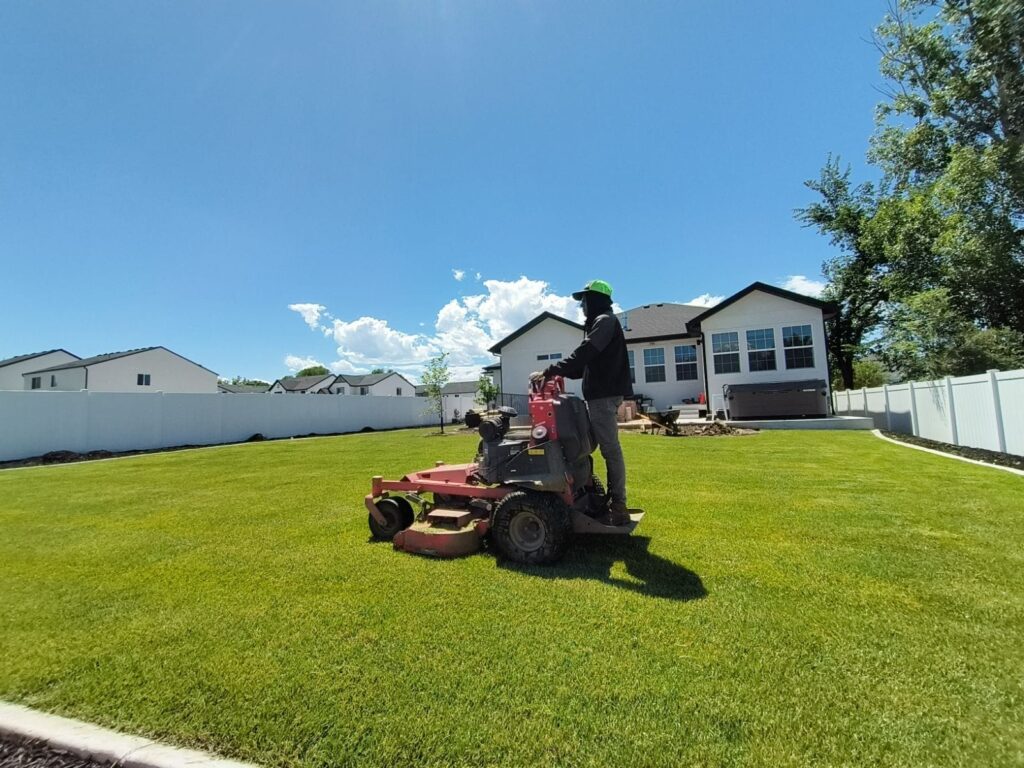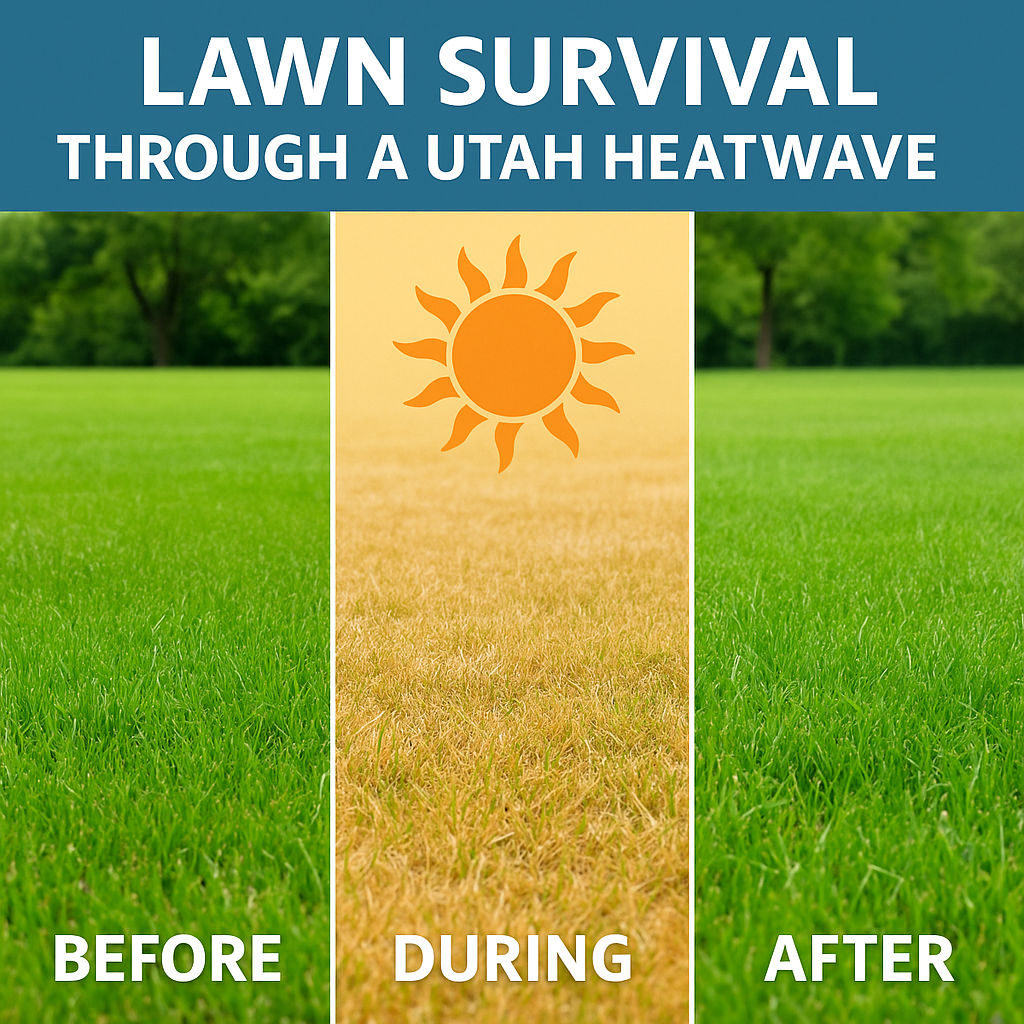When temperatures soar in Lehi, Utah, your lawn is on the frontlines. Scorching sun, dry air, and unpredictable watering routines can turn a lush, green lawn into a brown, brittle mess—fast. But what happens if you’re out of town, forgetful, or just overwhelmed? Can your lawn survive a Utah heatwave without you?
The short answer: maybe. But only if you’ve prepped it right.
This guide breaks down the science of summer turf stress, how to protect your lawn in Utah heat, and the top summer lawn care mistakes Utah homeowners make—so you can avoid a costly recovery later.
The Truth About Utah Heatwaves and Lawn Survival
Utah’s climate is high-desert—hot, dry, and unforgiving in summer. That means heatwaves don’t just dry out your lawn—they shift it into survival mode. But how your lawn responds depends on how you’ve cared for it before the stress hits.
Here’s what happens during a typical heatwave:
- Soil temperature exceeds 80°F, reducing moisture retention
- Grass shuts down new growth to conserve energy
- Weak or over-mowed lawns begin browning at the tips
- Shallow roots dry out first, accelerating dormancy or damage
In Lehi, heatwaves are often paired with watering restrictions or timing challenges. That’s why prepping early is essential.
Deep Watering vs. Daily Light Watering: One Makes Things Worse
You might think daily watering is better in high heat—but that’s a myth. In fact, daily light watering barely penetrates the soil. It trains your grass to form shallow roots that dry out faster when real heat hits.
What you should do instead:
Water deeply 2–3 times per week, soaking the soil 6–8 inches deep. This promotes deep root growth, which helps your lawn stay hydrated longer—even when you’re not home.
Bonus Tip: Water early in the morning (between 4–8 a.m.) to reduce evaporation and fungal risk.
Don’t Mow Too Short During Heatwaves
Short grass might look tidy—but in summer, it acts like a sunburn magnet. Cutting your lawn too low strips away its protective layer of shade and increases the risk of sunscald and soil drying.
Ideal mowing height during heat:
Keep cool-season grasses (like Kentucky bluegrass or tall fescue) at 3.5 to 4 inches during the peak of summer. Taller blades shade the roots and help retain soil moisture.
Pro Tip: Always use sharp mower blades to avoid tearing the grass and exposing it to further stress.
What Dormancy Really Looks Like (And Why It’s Not Always Bad)
A brown lawn isn’t always a dead lawn. In Utah, heat-induced dormancy is a natural defense mechanism where grass temporarily shuts down to survive drought.
Signs of dormancy vs. dead grass:
- Uniform straw-colored grass = dormancy
- Patchy yellowing or bare spots = possible damage
- Tug test: Dormant grass resists pulling; dead grass comes up easily
Dormancy can last up to 4–6 weeks without harming the lawn—if you’ve supported it beforehand with good practices like deep watering and proper mowing.
What to Do Before and After a Heatwave Hits
Before:
- Water deeply 24–48 hours before extreme temps arrive
- Raise your mowing height to 4 inches
- Apply a slow-release fertilizer with potassium (not nitrogen-heavy)
- Mulch grass clippings to shade and feed the soil
After:
- Resume deep watering gradually (don’t shock the lawn)
- Spot-aerate areas with high foot traffic
- Refrain from mowing until the lawn begins to green up
- Overseed thin patches in early fall, not mid-summer
These proactive steps give your lawn a fighting chance—even if you’re not around during the hottest weeks.
Can Smart Planning Let Your Lawn Survive Without You?
Yes—if you prepare.
Lehi’s summer weather isn’t getting any cooler. Heatwaves are becoming more frequent and intense. But with proper mowing height, deep watering, and a healthy root system, your lawn can ride out the heat—even if you’re on vacation.
Just don’t leave it to chance.
Frequently Asked Questions
Q: How can I tell if my lawn is dormant or dead?
A: Dormant grass turns straw-colored evenly, and you can’t pull it up easily. Dead grass will lift from the soil and appear patchy or gray.
Q: Should I fertilize during a heatwave?
A: No. Fertilizing in high heat can burn the lawn. Use slow-release fertilizers only before or after a heatwave—not during.
Q: Is daily watering ever okay in Utah?
A: No. It promotes shallow root growth and higher evaporation. Deep watering 2–3 times a week is better.
Q: Can I mow during a heatwave?
A: Only if necessary, and only with sharp blades. Raise your mowing height and avoid cutting during the hottest part of the day.

Need help keeping your lawn alive during extreme heat?
At Saratoga Mowing, we understand the climate, soil, and seasonal timing that affects lawns in Utah. We offer customized lawn care services for Lehi homeowners, including weekly mowing, watering guidance, and turf protection strategies.
👉 Get a free quote now and give your lawn a heatwave survival plan it can count on.


